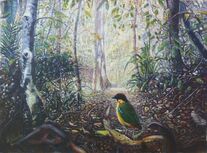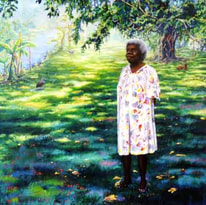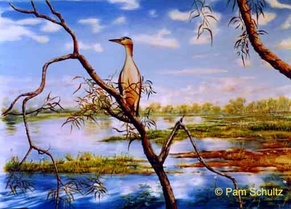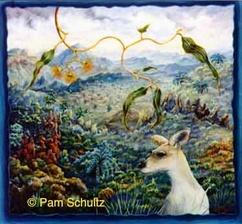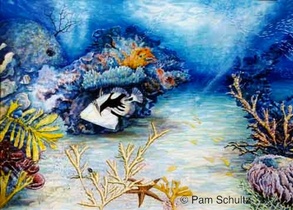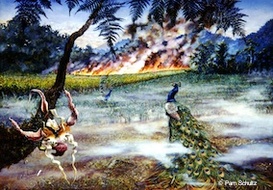History in Paint
An award-winning painter, Pam developed her fine art style while living in subtropical North Queensland amongst sugar-cane fields and mountains of pristine rainforest and creeks. Historically, she rejected representational images and this, she supposes, was a result of an art college education that emphasised the abstract and the emotional content through expressionism, although during her schooling she was attracted to Surrealism, Romanticism and the Pre-Raphaelite Brotherhood movement. Pam's natural bent was for representational and realistic images but with compositions that also evoke the emotions. She hopes to influence people to look around themselves and see what they are doing to the environment. Consequently, Pam recently started a portrait series to promote conservation ecologists who volunteer to save or improve what is left of the natural environment.
Go Straight to the images of the 'series' paintings.
Her first series were 'walk-in impressions' of closed-in canopy rainforest. They featured water, birds, insects and reptiles. in her colourful and compelling first images of her professional art career. Some of these can be found in the Cairns Regional Council's art collection as she won many acquisitive painting prizes during these first years in North Queensland in the 1980s.
Stepping out of the enclosed canopy space and into the immediate rural landscape opened the way to the second series of "Landscapes' of predominantly sugar-cane fields that dominated the area.
The third series that featured 'Wetlands' was influenced by a trip to Kakadu, Australia's largest National Park and World Heritage listed area in the Northern Territory.
The fourth series was the 'Outback.' That series was fuelled by several field trips around Australia and by far incorporated the largest body of work.
Always up for the next methodological challenge, Pam decided to develop her watercolour techniques for her fifth series with marine based or 'Reef' scenes, using stencils with beach and sea objects.
Time to introduce the human element with the sixth series showing the impact of humans on the landscape and the introduction of incredible skies affected by fire and smoke with the 'cane fire' series of paintings . These were the subjects for the opening of the Pam Schultz Gallery.
The seventh series depicted 'historical buildings' that were fast disappearing from the sugar industry landscape. These included barracks, mills and old sheds and houses.
The eighth series comprises of portraits of people. These are ongoing and feature conservation ecologists whose voluntary conservation work is paramount in their lives. Juxtaposed these are Pam's latest ventures into new styles and experiements with her 'Habitat' series.
The painting series were Pam's commercial arm but sometimes they incorporated major works. It is hoped that the major works fuel the imagination of the viewer with more intimate reflections of nature and the mystical feeling that they evoke. An example of this is depicted in the Landscapes series; "What Was, And What Will Be" seen below.
Go Straight to the images of the 'series' paintings.
Her first series were 'walk-in impressions' of closed-in canopy rainforest. They featured water, birds, insects and reptiles. in her colourful and compelling first images of her professional art career. Some of these can be found in the Cairns Regional Council's art collection as she won many acquisitive painting prizes during these first years in North Queensland in the 1980s.
Stepping out of the enclosed canopy space and into the immediate rural landscape opened the way to the second series of "Landscapes' of predominantly sugar-cane fields that dominated the area.
The third series that featured 'Wetlands' was influenced by a trip to Kakadu, Australia's largest National Park and World Heritage listed area in the Northern Territory.
The fourth series was the 'Outback.' That series was fuelled by several field trips around Australia and by far incorporated the largest body of work.
Always up for the next methodological challenge, Pam decided to develop her watercolour techniques for her fifth series with marine based or 'Reef' scenes, using stencils with beach and sea objects.
Time to introduce the human element with the sixth series showing the impact of humans on the landscape and the introduction of incredible skies affected by fire and smoke with the 'cane fire' series of paintings . These were the subjects for the opening of the Pam Schultz Gallery.
The seventh series depicted 'historical buildings' that were fast disappearing from the sugar industry landscape. These included barracks, mills and old sheds and houses.
The eighth series comprises of portraits of people. These are ongoing and feature conservation ecologists whose voluntary conservation work is paramount in their lives. Juxtaposed these are Pam's latest ventures into new styles and experiements with her 'Habitat' series.
The painting series were Pam's commercial arm but sometimes they incorporated major works. It is hoped that the major works fuel the imagination of the viewer with more intimate reflections of nature and the mystical feeling that they evoke. An example of this is depicted in the Landscapes series; "What Was, And What Will Be" seen below.
|
Habitats
Title: Noisy Pitta Waiting Pam says. "One cannot be more overwhelmed than the plethora of species surrounding you in the Wet Tropics, North Queensland, Australia. The number of species is astounding and there is always more to discover." |
Portraits
Title: Annie Wonga at Home Pam Says, "Our first Nations People have been the victims of a shocking history of subjugation in Australia. Not the first portrait of an Aboriginal that I have done but I hope the painting has captured her aura of loving kindness at the special place she calls home." |
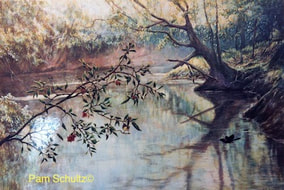
Walk-in Impressions
[Link] Title: Alice River Wrens Pam Says, "Rejecting the idea of being a landscape artist in a realist representational way was a legacy of art college education, I believe." |
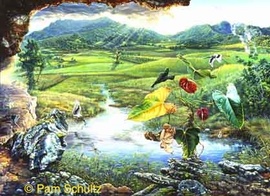
Landscapes
Title: What Was, And What Will Be Pam says, "Stepping out of the closed canopy 'walk-in impressions' was the next challenge for me. I loved the landscape around Babinda that nestles between Mt Bartle Frere (1622m) and Mt Bellenden Ker (1593m), the two highest mountains in Queensland of the Wooroonoonan Range" |
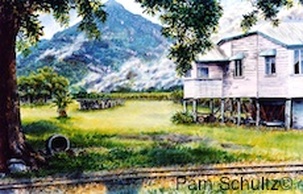
Historic Buildings
Title: Pyramid on Fire "This cane fire painting features a typical Queenslander farm house, usually made of silky oak or other wood of the locale, erected on stumps and has a steeply pitched roof." |
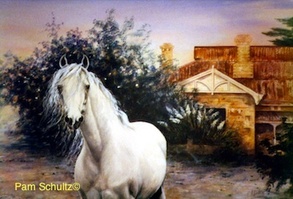
Portraits [link]
Title: Judohn "I love horses and all animals. Judohn was a pure bred Arabian stallion at Waverny Stud in Strathalbyn, South Australia. It was one of many first jobs." |
